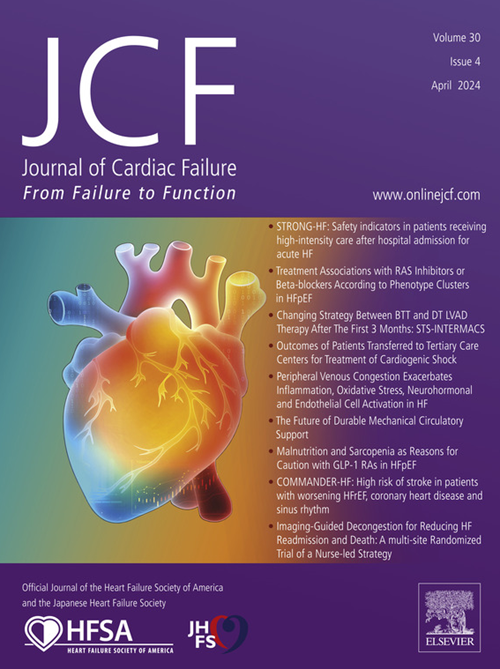Clinical Outcomes of Patients Experiencing Transient Loss of Pulse Pressure During High-Risk PCI with Impella
IF 6.7
2区 医学
Q1 CARDIAC & CARDIOVASCULAR SYSTEMS
引用次数: 0
Abstract
Background
Patients experiencing loss of pulse pressure (LOPP) during high-risk percutaneous coronary intervention (HR-PCI) are transiently dependent on mechanical circulatory support devices. We sought to define the frequency and clinic outcomes of patients who experience LOPP during HR-PCI.
Methods and Results
Patients enrolled in the PROTECT III study and had automated Impella controller logs capturing real-time hemodynamics were included in this analysis. A LOPP event was defined as a mean pulse pressure on Impella of <20 mm Hg for ≥5 seconds during PCI. Clinical characteristics and outcomes were then compared between those with and without LOPP. Logistic regression identified clinical and hemodynamic predictors of LOPP. We included 302 patients, of whom 148 patients (49%) experienced LOPP. Age, sex, and comorbidities were similar in patients with and without LOPP. Mean baseline systolic blood pressure (118.6 mm Hg vs 129.8 mm Hg; P < .001) and mean arterial pressure (86.9 mm Hg vs 91.6 mm Hg; P = .011) were lower in patients with LOPP, whereas heart rate (78 bpm vs 73 bpm; P = .012) was higher. Anatomical complexity was similar between groups. Patients with LOPP were more likely to experience major adverse cardiac and cerebrovascular events (23.5% vs 8.8%; P = .002), acute kidney injury (10.1% vs 2.6%; P = .030), and death (20.2% vs 7.9%; P = .008) within 90 days. A low baseline systolic blood pressure and cardiomyopathy were the strongest predictors of LOPP (P = .003 and P = .001, respectively).
Conclusions
LOPP on Impella during HR-PCI was common and occurred more frequently in patients with cardiomyopathy and a low systolic blood pressure. LOPP was strongly associated with higher 90-day major adverse cardiac and cerebrovascular events, acute kidney injury, and mortality.
Condensed Abstract
We sought to define the frequency and clinic outcomes of patients who experience LOPP during high-risk percutaneous coronary intervention (HR-PCI). We included 302 patients, of whom 148 (49%) experienced LOPP. Patients with LOPP were more likely to experience major adverse cardiac and cerebrovascular events (23.5% vs 8.8%; P = .002), acute kidney injury (10.1% vs 2.6%; P = .030), and death (20.2% vs 7.9%; P = .008) within 90 days. A low baseline systolic blood pressure and cardiomyopathy were the strongest predictors of LOPP (P = .003 and P = .001, respectively).
使用 Impella 进行高风险 PCI 期间出现短暂脉压下降的患者的临床疗效。
背景:在高风险经皮冠状动脉介入治疗(HR-PCI)过程中出现脉搏失压(LOPP)的患者会暂时依赖于机械循环支持装置。我们试图确定在 HR-PCI 过程中出现 LOPP 的患者的频率和临床结果:参加 PROTECT III 研究并有 Impella 控制器自动日志记录实时血流动力学的患者被纳入本次分析。LOPP事件定义为Impella上的平均脉压达到结论:HR-PCI 期间 Impella 的 LOPP 很常见,在心肌病和收缩压较低的患者中发生得更频繁。LOPP 与较高的 90 天主要不良心脑血管事件、急性肾损伤和死亡率密切相关。摘要 我们试图确定在高风险经皮冠状动脉介入治疗(HR-PCI)过程中出现 LOPP 的患者的频率和临床结果。我们纳入了 302 名患者,其中 148 人(49%)经历过 LOPP。LOPP 患者更有可能在 90 天内发生重大不良心脑血管事件(23.5% vs 8.8%;P = .002)、急性肾损伤(10.1% vs 2.6%;P = .030)和死亡(20.2% vs 7.9%;P = .008)。低基线收缩压和心肌病是预测 LOPP 的最有力因素(分别为 P = .003 和 P = .001)。
本文章由计算机程序翻译,如有差异,请以英文原文为准。
求助全文
约1分钟内获得全文
求助全文
来源期刊

Journal of Cardiac Failure
医学-心血管系统
CiteScore
7.80
自引率
8.30%
发文量
653
审稿时长
21 days
期刊介绍:
Journal of Cardiac Failure publishes original, peer-reviewed communications of scientific excellence and review articles on clinical research, basic human studies, animal studies, and bench research with potential clinical applications to heart failure - pathogenesis, etiology, epidemiology, pathophysiological mechanisms, assessment, prevention, and treatment.
 求助内容:
求助内容: 应助结果提醒方式:
应助结果提醒方式:


